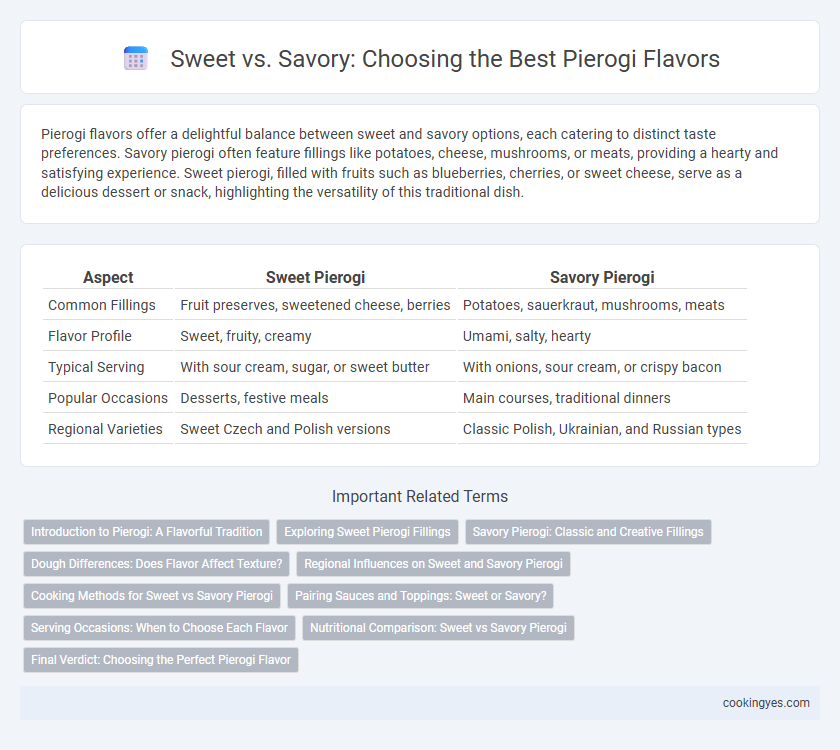Pierogi flavors offer a delightful balance between sweet and savory options, each catering to distinct taste preferences. Savory pierogi often feature fillings like potatoes, cheese, mushrooms, or meats, providing a hearty and satisfying experience. Sweet pierogi, filled with fruits such as blueberries, cherries, or sweet cheese, serve as a delicious dessert or snack, highlighting the versatility of this traditional dish.
Table of Comparison
| Aspect | Sweet Pierogi | Savory Pierogi |
|---|---|---|
| Common Fillings | Fruit preserves, sweetened cheese, berries | Potatoes, sauerkraut, mushrooms, meats |
| Flavor Profile | Sweet, fruity, creamy | Umami, salty, hearty |
| Typical Serving | With sour cream, sugar, or sweet butter | With onions, sour cream, or crispy bacon |
| Popular Occasions | Desserts, festive meals | Main courses, traditional dinners |
| Regional Varieties | Sweet Czech and Polish versions | Classic Polish, Ukrainian, and Russian types |
Introduction to Pierogi: A Flavorful Tradition
Pierogi, traditional Eastern European dumplings, showcase a versatile range of flavors that cater to both sweet and savory preferences. Popular savory fillings include potatoes, cheese, sauerkraut, and meat, while sweet variants often feature fruits like blueberries or sweet cheese. This diverse flavor profile highlights pierogi's cultural significance and enduring appeal in global cuisine.
Exploring Sweet Pierogi Fillings
Sweet pierogi fillings often feature ingredients like sweetened farmer's cheese, fresh fruits such as blueberries or strawberries, and rich jams that create a delightful contrast to their tender dough. Traditional flavors include sweetened cottage cheese mixed with vanilla and sugar, or fruits like cherries and plums that offer natural tartness balanced by sweetness. These sweet varieties provide a unique dessert option that complements the savory staples commonly found in Eastern European cuisine.
Savory Pierogi: Classic and Creative Fillings
Savory pierogi fillings range from classic options such as potato and cheese, sauerkraut with mushrooms, and ground meat to creative combinations like spinach and feta or smoked sausage with caramelized onions. These hearty flavors showcase Eastern European culinary traditions while allowing innovative twists that cater to contemporary palates. Seasonings like dill, garlic, and black pepper enhance the rich, comforting taste of savory pierogi, making them a versatile meal for any occasion.
Dough Differences: Does Flavor Affect Texture?
Sweet pierogi dough often incorporates sugar and sometimes vanilla or cinnamon, resulting in a softer, more tender texture that complements fruity or creamy fillings. Savory pierogi dough tends to be denser and more elastic, typically made with less sugar and sometimes enriched with sour cream or potatoes to hold robust fillings like potatoes, cheese, or meat. These ingredient variations influence the dough's moisture content and gluten development, directly affecting the pierogi's texture and overall mouthfeel based on the chosen flavor profile.
Regional Influences on Sweet and Savory Pierogi
Regional influences greatly shape the sweet and savory pierogi flavors, with Eastern European countries like Poland favoring savory fillings such as potato, cheese, and sauerkraut, while Ukrainian pierogi often feature sweet fillings like cherries and berries. In areas like Galicia, the combination of both sweet and savory pierogi on festive tables highlights cultural blending, where sour cabbage and mushroom pierogi coexist with fruit-filled varieties. These regional preferences reflect local agricultural products and culinary traditions, making pierogi a versatile dish across Slavic and Central European cuisines.
Cooking Methods for Sweet vs Savory Pierogi
Sweet pierogi often feature fillings like fruit preserves, sweetened cheese, or cinnamon-spiced mixtures, and are typically boiled then pan-fried in butter to enhance caramelization and develop a golden crust. Savory pierogi, filled with ingredients such as potatoes, sauerkraut, mushrooms, or meat, are generally boiled and served with toppings like sauteed onions, sour cream, or bacon bits to complement their hearty flavors. Both cooking methods emphasize boiling for a tender dough, while frying adds texture and enriches the distinct flavor profiles, making each variation distinct yet complementary.
Pairing Sauces and Toppings: Sweet or Savory?
Pierogi flavors can be distinctly categorized into sweet and savory, each paired with complementary sauces and toppings to enhance their taste profile. Sweet pierogi often feature fillings such as fruit preserves, sweet cheese, or poppy seeds, paired ideally with toppings like powdered sugar, cinnamon, honey, or fruit compotes to balance sweetness and texture. Savory pierogi fillings include potatoes, cheese, sauerkraut, or meat, typically accompanied by sour cream, caramelized onions, mushrooms, or crispy bacon bits to intensify umami flavors and richness.
Serving Occasions: When to Choose Each Flavor
Sweet pierogi flavors like fruit-filled or sweet cheese varieties are ideal for desserts, festive holidays, or breakfast occasions where a touch of sweetness enhances the meal. Savory pierogi options, such as those filled with potatoes, cheese, sauerkraut, or meat, are best suited for lunch, dinner, or hearty gatherings that call for filling, robust flavors. Choosing sweet or savory pierogi depends on the meal context and desired flavor profile, ensuring the perfect match for celebrations, family meals, or casual snacking.
Nutritional Comparison: Sweet vs Savory Pierogi
Sweet pierogi, often filled with fruits like blueberries or sweet cheese, generally contain higher sugar content and provide a quick energy boost through natural carbohydrates. Savory pierogi, featuring fillings such as potatoes, cheese, or meat, offer more protein and fat, contributing to greater satiety and sustained energy release. Nutritionally, the choice between sweet and savory pierogi impacts calorie distribution, glycemic index, and vitamin content, with savory options typically providing more balanced macronutrients and essential minerals.
Final Verdict: Choosing the Perfect Pierogi Flavor
Savory pierogi flavors such as potato and cheese, sauerkraut, or meat offer rich, hearty fillings that appeal to those seeking traditional Eastern European tastes. Sweet pierogi options, featuring fillings like fruit preserves or sweet cheese, provide a delightful dessert-like experience that balances softness with a touch of sweetness. Selecting the perfect pierogi flavor depends on personal preference and occasion, with savory varieties serving as satisfying main dishes and sweet options ideal for a comforting treat or dessert.
Sweet vs Savory for Pierogi Flavors Infographic

 cookingyes.com
cookingyes.com